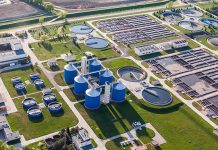Data is changing our world and the way we live and work at an unprecedented pace. It is transforming the way the water industry operates and is becoming increasingly critical. With the massive growth in data and the Internet of Things, plus rapidly evolving methods for analysing data, the importance of data across every aspect of the water sector will only intensify.
Undoubtedly the sheer amount of data water utilities are creating is big, but the expression ‘big data’ is far too basic, focusing on the volume instead of the tremendous opportunities data and analytics create. There needs to be a better phrase that describes the enormous shift in technology, culture and the world. It doesn’t matter how much data water utilities have, it is whether they use it successfully to generate actionable insight that is essential.
Using data strategically
In order to succeed, water utilities must begin to question everything, starting with their strategy. If water companies want to become a data business, they need a robust and inclusive data strategy covering decision making, operations and data as a business asset, otherwise known as monetisation.
Welsh Water’s data strategy is known as WISER (Welsh Water Information Strategy Enterprise Roadmap). The aim, is for the business to govern and manage its data in a disciplined and co-ordinated manner to optimise the value of our investment in data assets, support effective and efficient operations, mitigate legal and regulatory risk and ultimately improve the delivery of services to our customers and stakeholders.
The data strategy acts as a roadmap for what Welsh Water want to achieve and what we need to put in place for that to happen, including firstly a comprehensive data governance programme, that acts as the building blocks for the analytics, followed by data collection methods, analytical tools, infrastructure investments and upskilling the Data Science talent and other data teams across the business. As well as a sequence of actions, it is about creating a data culture and moving beyond data silos to a more joined up approach where everyone across the business understands the value of data as a key business asset and data becomes at the heart of all decision making and business operations. The pressure on water companies today are ever increasing; pressures to comply with regulatory and industry standards; to reduce cost and improve efficiencies; to meet customer expectations and pressures to operate in an uncertain and constantly changing economy. To be able to meet these demands, the water industry must rely on combining consistent, accurate and reliable data to provide real insights that can be used to improve knowledge, understanding and decision making about the business, operations and ultimately the customer. Consequently a successful data governance programme is the cornerstone for data transformation and requires strategy, people, process and technology. It is important for water and wastewater companies to think about these components in this precise order. Some companies make the mistake of acquiring technology before they have fully outlined the strategy, people and process components of their data governance program. This typically results in problems because the requirements of the technology cannot be clear without first defining the path of the data governance program.
Data in practice
For Welsh Water, the ultimate goal of data governance is to deliver business value quicker and with greater accuracy, by saving money; ensuring data reliability, consistency and repeatability; guiding all current and future analytic activities and improving confidence and clarity. A compelling technology platform that is adaptable to changes in the technology environment is crucial to provide the agility required to meet the needs of the business.
There are three analytical buckets for a water utility – product and device analytics; network and operational analytics, and customer and employee analytics. The first focuses on physical items within the water sector, such as equipment and machines. For example, undertaking predictive maintenance which predicts when certain equipment or devices are in need of maintenance, what sort of maintenance, or the likely maintenance and replacement materials. Or carrying out maintenance scheduling optimisation which improves the planning of resources, in order to optimise the replacement and upgrading of failing or under-performing parts of products. Else, balancing maintenance, repair and operations (MRO) inventory with predictive maintenance needs in order to reduce inventory costs and minimise obsolete and excessive inventory via maintenance MRO inventory optimisation.
Analytics about networks and operations can include predictive models to reduce the likelihood of non-compliance within water or wastewater operations; network performance optimisation that predicts and optimises waste or water network performance across multiple usage scenarios. Or it can include identifying, monitoring and pre-emptively predicting the failure of unplanned operational, network or resource interruption at assets to reduce unplanned downtime.
One successful example of operational analytics within Welsh Water is the service reservoir (SRV) bacteriological predictive model that provides a ‘risk score’ for every sample taken at each SRV, essentially providing the likelihood of a sample failure occurring. The model has been deployed and embedded within the water operational teams to help maximise compliance and enhance the benefits of predictive analytics in the reservoir management process. A second example is a waste initiative, known as the Treatment Performance Forecasting (TPF) model, where models have been constructed to predict effluent non-consent at wastewater treatment works for Ammonia, Biological Oxygen Demand and Total Suspended Solids.
Improving customer service
Water utilities are one of many business-to-consumer industries that can benefit directly from data and analytics. Data allows water and wastewater companies to map the DNA of their customers and if water companies ensure the privacy of their customers is not threatened, data and analytics can deliver personalised insights that provide a holistic view of their customers. The benefits of such knowledge and understanding can help the water industry better understand customer sentiment and water usage; improve customer engagement; influence Service Incentive Mechanism (SIM) and customer behaviour enabling companies to obtain a customer centric view of their world and organise information accordingly to support the needs of their increasingly vocal and social customers.
Today’s consumers expect their water utilities to provide the same high standards of customer and user experience, as the on-line social networks and e-commerce leaders provide their customers, especially with the media attention given to ‘smart’ infrastructure upgrades. It is imperative for water and waste water companies to take the long view and build a robust and competitive data capability to manage their data and information, and support their future business operations in an efficient and sustainable manner.
Data and analysis is no longer just for data people. Water utilities need to ensure that data has equal attention on the same level as customer, operational and talent strategies, especially given developments in robotics and artificial intelligence that will naturally have an impact on business models and every day operations within the water sector.
Data can help water utilities run their operations more efficiently, reduce costs and risks, improve compliance, better understand customers and help provide a targeted and personalised customer service. It is an exciting time for the water industry, and data is as the centre of it.
www.dwrcymru.com







